 As the days finally start getting longer, it’s a good time to look back on the remarkable year that Magnificat enjoyed in 2010 – our biggest audiences ever, two appearances at the Berkeley Festival, the release of the first volume of Cozzolani’s complete works and, of course, lots and lots of spectacular music. In the past twelve months Magnificat performed 16 times in venues ranging from Yoshi’s to Grace Cathedral. We performed music by Alessandro Grandi, Claudio Monteverdi, Barbara Strozzi, Antonio Vivaldi, Chiara Margarita Cozzolani, John Blow, Marc-Antoine Charpentier, Nicolas LeBegue, Biagio Marini, and Dario Castello.
As the days finally start getting longer, it’s a good time to look back on the remarkable year that Magnificat enjoyed in 2010 – our biggest audiences ever, two appearances at the Berkeley Festival, the release of the first volume of Cozzolani’s complete works and, of course, lots and lots of spectacular music. In the past twelve months Magnificat performed 16 times in venues ranging from Yoshi’s to Grace Cathedral. We performed music by Alessandro Grandi, Claudio Monteverdi, Barbara Strozzi, Antonio Vivaldi, Chiara Margarita Cozzolani, John Blow, Marc-Antoine Charpentier, Nicolas LeBegue, Biagio Marini, and Dario Castello.
 Our first performances of the year were also the first performances in almost 400 years of the first works designated as “cantatas.” Soprano Laura Heimes was featured in a program that included three cantatas, a madrigal and a sonnet from Alessandro Grandi’s 1620 collection Cantade et Arie, in which the composer used to the term “cantada” to distinguish three settings of strophic poetry for soprano and continuo. Each of the works employs a compositional strategy identified by musicologists as “strophic bass” cantatas, an example of strophic variation with which many composers were experimenting at the time. Sadly, the only copy of Grandi’s historic 1620 collection thought to survive into the 20th century was destroyed in the Second World War, a previously unidentified copy of the print was uncovered recently and, working with musicologists Giulia Giovani and Aurelio Bianco, Magnificat had the honor of presenting some of Grandi’s collection for the first time in centuries.
Our first performances of the year were also the first performances in almost 400 years of the first works designated as “cantatas.” Soprano Laura Heimes was featured in a program that included three cantatas, a madrigal and a sonnet from Alessandro Grandi’s 1620 collection Cantade et Arie, in which the composer used to the term “cantada” to distinguish three settings of strophic poetry for soprano and continuo. Each of the works employs a compositional strategy identified by musicologists as “strophic bass” cantatas, an example of strophic variation with which many composers were experimenting at the time. Sadly, the only copy of Grandi’s historic 1620 collection thought to survive into the 20th century was destroyed in the Second World War, a previously unidentified copy of the print was uncovered recently and, working with musicologists Giulia Giovani and Aurelio Bianco, Magnificat had the honor of presenting some of Grandi’s collection for the first time in centuries.
 In April, we went from a modern premiere to perhaps the best known work from the 17th Century, Monteverdi’s Vespers of 1610, celebrating the 400th anniversary of this watershed publication with three performances, including one at San Francisco’s Grace Cathedral. “With Monteverdi’s 1610 Vespers, Magnificat is approaching music that is generally familiar to our audience — many of whom have even sung the piece — and each of the musicians involved can list multiple performances of the work on their resumes,” noted Artistic Director Warren Stewart. “Yet turning to Monteverdi’s familiar music together is no less a revelation than any premiere, especially in the company of musical friends that bring such a breadth of experience with them to the performances.” Magnificat was joined for these performances by the early wind ensemble The Whole Noyse.
In April, we went from a modern premiere to perhaps the best known work from the 17th Century, Monteverdi’s Vespers of 1610, celebrating the 400th anniversary of this watershed publication with three performances, including one at San Francisco’s Grace Cathedral. “With Monteverdi’s 1610 Vespers, Magnificat is approaching music that is generally familiar to our audience — many of whom have even sung the piece — and each of the musicians involved can list multiple performances of the work on their resumes,” noted Artistic Director Warren Stewart. “Yet turning to Monteverdi’s familiar music together is no less a revelation than any premiere, especially in the company of musical friends that bring such a breadth of experience with them to the performances.” Magnificat was joined for these performances by the early wind ensemble The Whole Noyse.
 In addition to our own 2009-2010 season, Magnificat also appeared twice at the Berkeley Early Music Festival in June. On June 11, we presented a program that featured nine motets by Chiara Margarita Cozzolani, eight of which we had just recorded in completion of our project to record her complete works. Volume I of the two volume set for formally released ina CD release party at Yoshi’s on June 7, though the actual delivery of the CDs was delayed due to printing issues. We have now begun the post production process for Volume II, which is now planned for release at our concerts in March 2011.
In addition to our own 2009-2010 season, Magnificat also appeared twice at the Berkeley Early Music Festival in June. On June 11, we presented a program that featured nine motets by Chiara Margarita Cozzolani, eight of which we had just recorded in completion of our project to record her complete works. Volume I of the two volume set for formally released ina CD release party at Yoshi’s on June 7, though the actual delivery of the CDs was delayed due to printing issues. We have now begun the post production process for Volume II, which is now planned for release at our concerts in March 2011.
 Magnificat also participated in the Festival Finale concert on June 13, a concert that featured all the mainstage ensembles from the Festival in a “Vespers from Monteverdi to Vivaldi.” It was an honor to join ARTEK, AVE, Archetti, the Marion Verbruggen Trio, Music’s Recreation and ¡Sacabuche! in Monteverdi’s hymn Ave maris stella and Vivaldi’s g minor Magnificat under the direction of Magnificat’s Artistic Director Warren Stewart. In addition, Magnificat performed Barabara Strozzi’s motet “O Maria” and the Dixit Dominue from Monteverdi’s 1610 Vespers.
Magnificat also participated in the Festival Finale concert on June 13, a concert that featured all the mainstage ensembles from the Festival in a “Vespers from Monteverdi to Vivaldi.” It was an honor to join ARTEK, AVE, Archetti, the Marion Verbruggen Trio, Music’s Recreation and ¡Sacabuche! in Monteverdi’s hymn Ave maris stella and Vivaldi’s g minor Magnificat under the direction of Magnificat’s Artistic Director Warren Stewart. In addition, Magnificat performed Barabara Strozzi’s motet “O Maria” and the Dixit Dominue from Monteverdi’s 1610 Vespers.
 Our 2010-2011 season opened in October with a production of John Blow’s Venus and Adonis. Again, these performances were something of a first – these were the first performances of Blow’s revised version of the work. Soprano Catherine Webster sung the part of Venus; countertenor José Lemos sang the role of Cupid; and bass Peter Becker was Adonis. Magnificat was joined in these performances by members of the San Francisco Girls Chorus, who made a cameo appearance as the little cupids. The edition for our performance was generously provided by The Purcell Society and Stainer and Bell.
Our 2010-2011 season opened in October with a production of John Blow’s Venus and Adonis. Again, these performances were something of a first – these were the first performances of Blow’s revised version of the work. Soprano Catherine Webster sung the part of Venus; countertenor José Lemos sang the role of Cupid; and bass Peter Becker was Adonis. Magnificat was joined in these performances by members of the San Francisco Girls Chorus, who made a cameo appearance as the little cupids. The edition for our performance was generously provided by The Purcell Society and Stainer and Bell.
 On the weekend of December 17-19, Magnificat performed Marc-Antoine Charpentier’s Messe de Minuit for three near-capacity crowds in Menlo Park, Berkeley and San Francisco. The program also included Charpentier’s Dialogus inter angelos et pastores and arrangements of many of the French noëls used by the composer in his delightful mass setting.
On the weekend of December 17-19, Magnificat performed Marc-Antoine Charpentier’s Messe de Minuit for three near-capacity crowds in Menlo Park, Berkeley and San Francisco. The program also included Charpentier’s Dialogus inter angelos et pastores and arrangements of many of the French noëls used by the composer in his delightful mass setting.
Of course we still have two programs remaining in the 2010-2011 season. On the weekend of February 4-6, a program featuring soprano Jennifer Ellis Kampani exploring the music of four remarkable women of the 17th Century: Francesca Caccini, Barbara Strozzi, Isabella Leonarda and Elisabeth Jacquet de la Guerre. The season will conclude March 18-20 with a staged production of Orazio Vecchi’s madrigal comedy L’Amfiparnaso in collaboration with commedia actors from the Dell’Arte Company.
Thanks to all the musicians appeared in Magnificat concerts during 2010 – Elizabeth Anker, Annette Bauer, Peter Becker, Meg Bragle, Louise Carslake, Daria D’Andrea, Hugh Davies, Rob Diggins, John Dornenburg, Jillon Stoppels Dupree, Paul Elliott, Ruth Escher, Steve Escher, Jeff Fields, Katherine Heater, Richard Van Hessel, Daniel Hutchings, Jennifer Lane, Christopher LeCluyse, Jennifer Ellis Kampani, José Lemos, Anthony Martin, Clifton Massey, Matthias Maute, Carla Moore, Herb Myers, Jennifer Paulino, Elisabeth Reed, Ernie Rideout, Robert Stafford, Sandy Stadtfeld, David Tayler, Brian Thorsett, Kiri Tollaksen, Hanneke van Proosdij, Jolianne von Einem, Catherine Webster, and David Wilson.
Many thanks as well to Magnificat’s Board of Directors: Nicholas Elsishans, John Golenski, Dorothy Manly, Michael Patterson, Michael Barger, Mickey Butts, Richard Fabian, Michael King and Chuck Thiel; our irreplaceable concert and stage team of Margriet Downing and Julianna Wetherwax; creative director Nika Korniyenko and recording magician Boby Borisov. Most of all thank you to all those that have supported us with donations, CD and ticket purchases and all the good will on Twitter and Facebook. We look forward to sharing beautiful music with all of you in the new year!

Here’s a sample of photographs from 2010. Lots more can be viewed on our Flickr page.
[nggallery id=8]
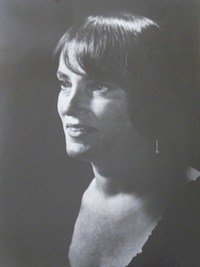 Along with all who were touched by her, I was deeply saddened to learn that soprano Judith Nelson had passed away earlier this year. Few musicians have had a bigger impact on me personally and Magnificat as an ensemble than Judy. She sang in over 40 Magnificat concerts in the 90s and appeared in one of the title roles (along with Paul Hillier) on Magnificat’s first recording, Cavalieri’s Rappresentatione di Anima e di Corpo. I also had the privilege of working with Judy in California Bach Society projects and in many other situations. But it was as a friend that I remember Judy the best and it is these memories that I treasure most.
Along with all who were touched by her, I was deeply saddened to learn that soprano Judith Nelson had passed away earlier this year. Few musicians have had a bigger impact on me personally and Magnificat as an ensemble than Judy. She sang in over 40 Magnificat concerts in the 90s and appeared in one of the title roles (along with Paul Hillier) on Magnificat’s first recording, Cavalieri’s Rappresentatione di Anima e di Corpo. I also had the privilege of working with Judy in California Bach Society projects and in many other situations. But it was as a friend that I remember Judy the best and it is these memories that I treasure most.







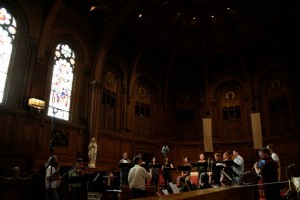
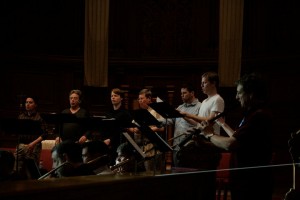
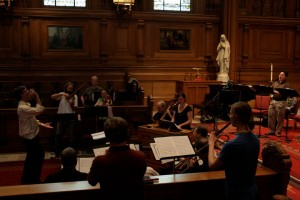
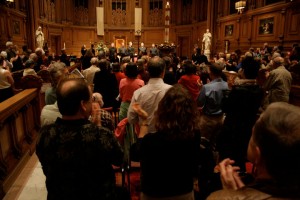

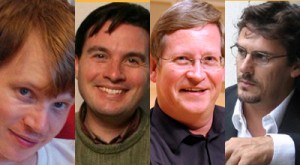


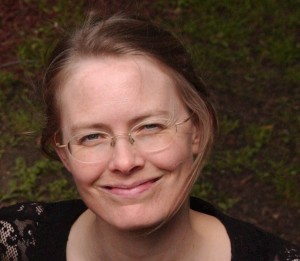
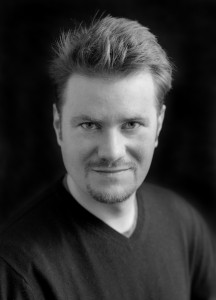







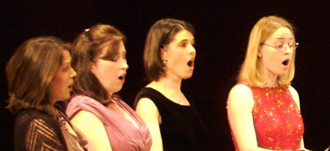


 We learned that
We learned that 

